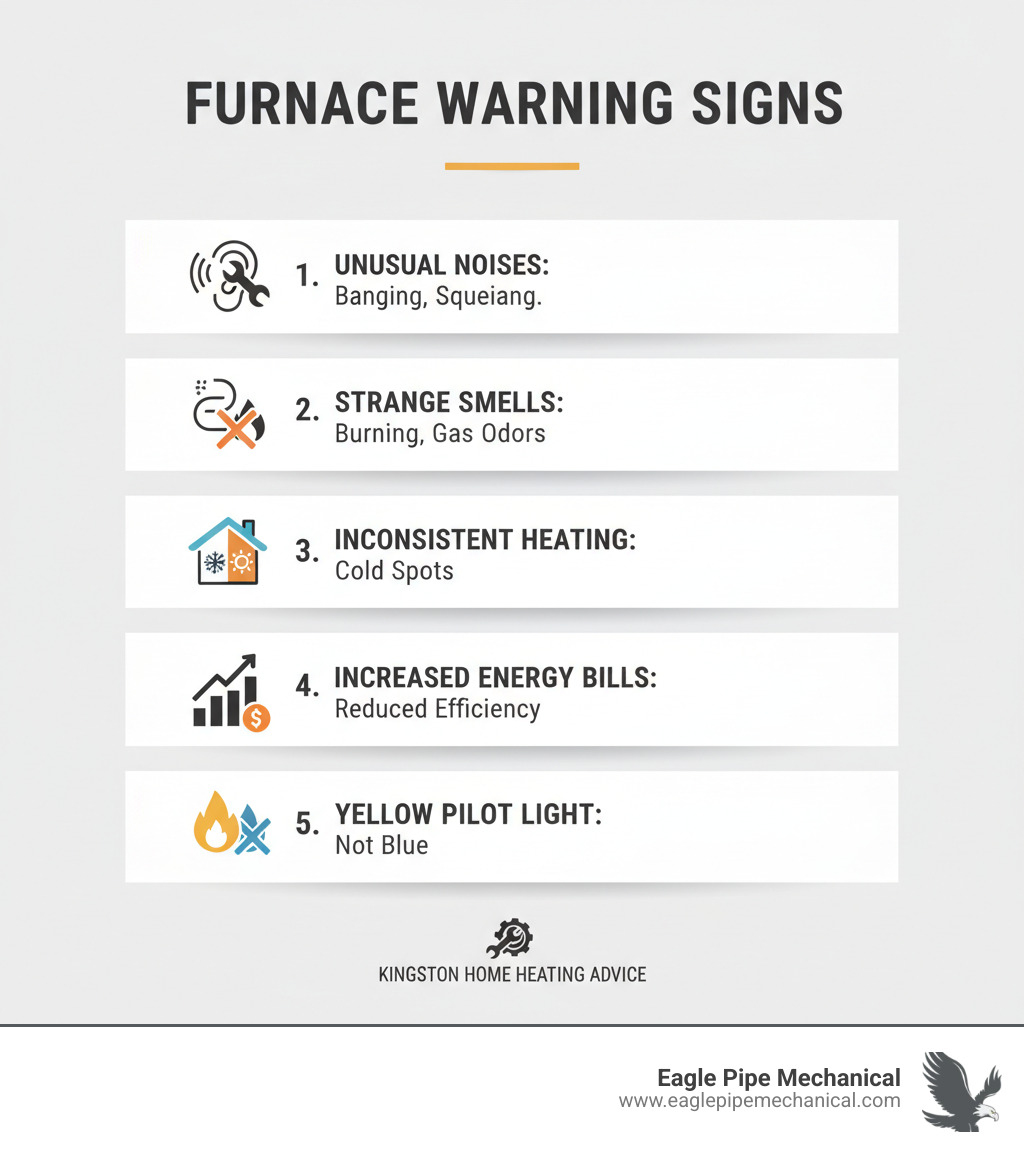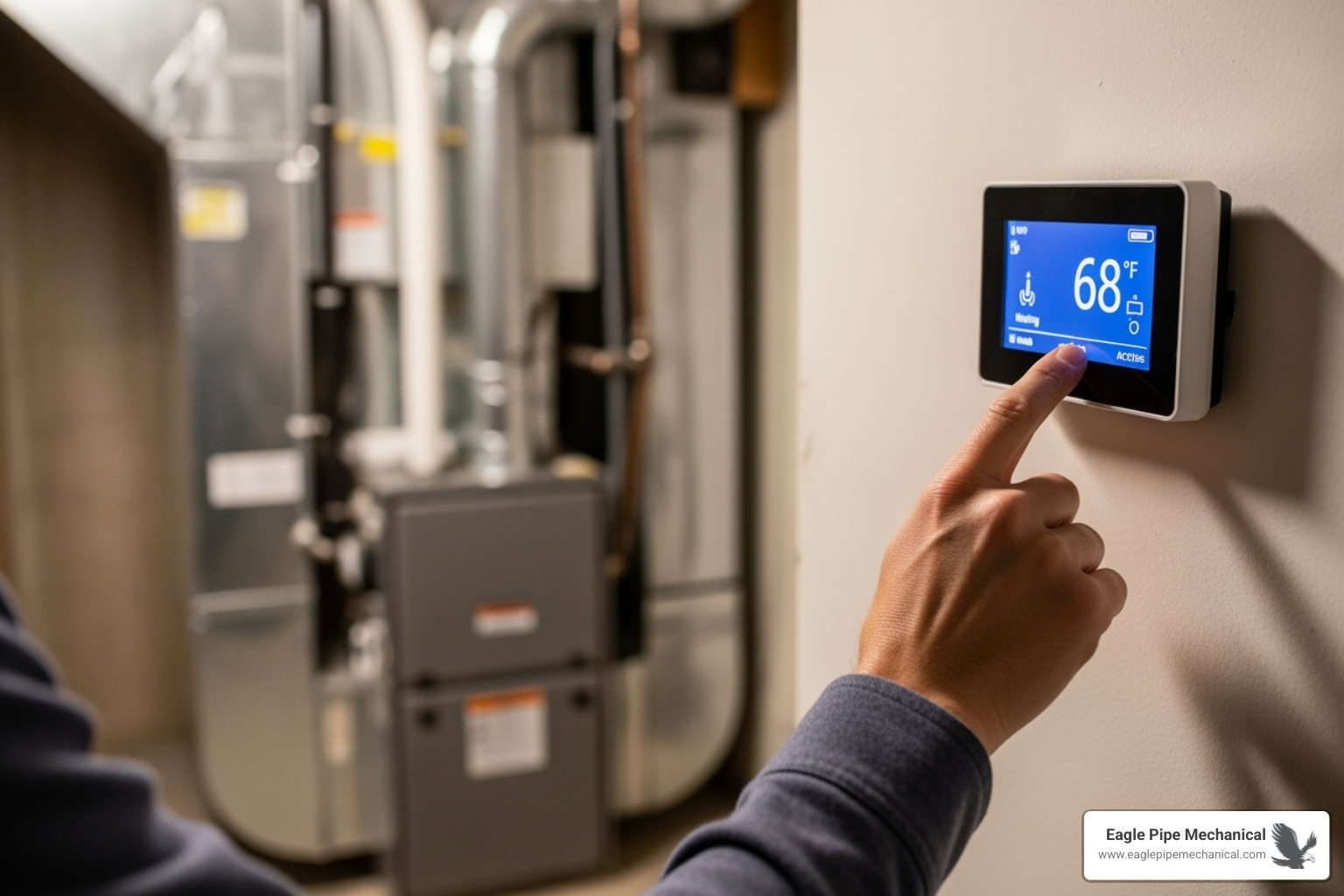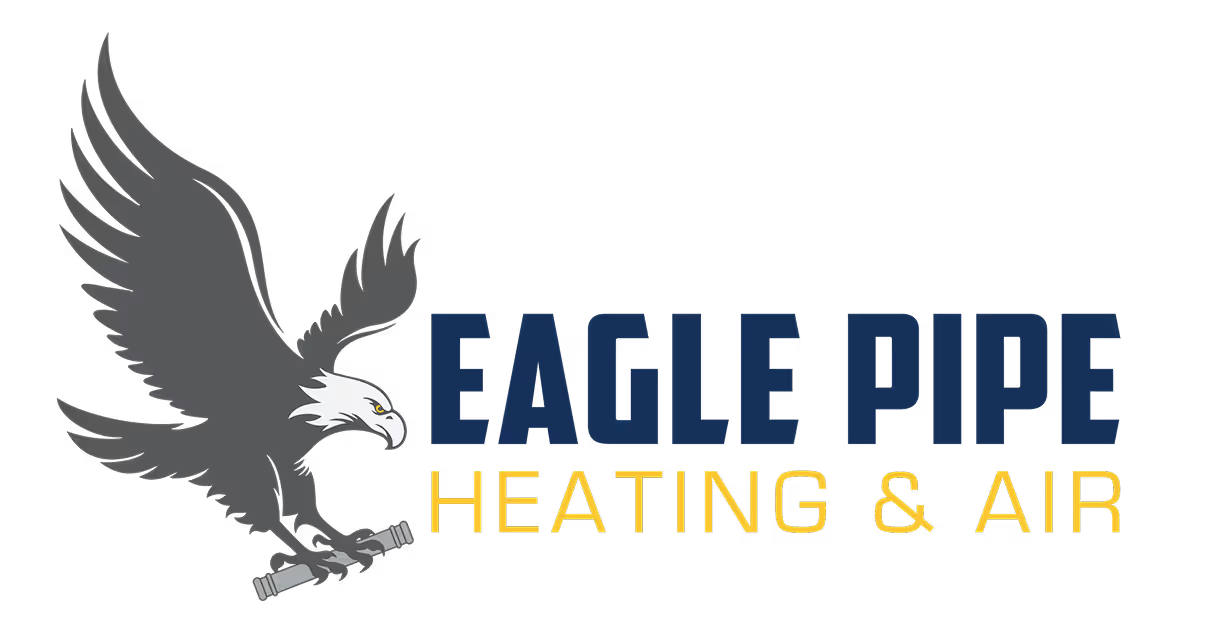Heating Repair Near Me for Instant Warmth

Why Kingston Homeowners Need Reliable Furnace Repair Solutions
When you need furnace repair Kingston services, you're likely dealing with a cold home and the stress of an unexpected breakdown. Here's what you need to know to get your heating system back up and running quickly:
Top Kingston Furnace Repair Companies:
- Haven Home Heating and Air Conditioning - 24/7 emergency service, 29+ years experience
- Tozer Heating & Air - Family-owned, local Kingston specialists
- Dows ClimateCare - Serving Kingston since 1992
- Reliance Home Comfort - 60+ years experience, next-day installation guarantee
Common Repair Issues:
- Ignition problems and pilot light failures
- Clogged filters causing overheating
- Thermostat malfunctions
- Blower motor issues
- Strange noises from worn components
Expected Costs: $200-$500 for minor repairs, $500-$2,000 for major fixes
Kingston's harsh winters don't wait for convenient timing when your furnace decides to quit. One moment you're enjoying a cozy evening, the next you're bundled in blankets wondering why your home feels like an icebox.
The good news? Most furnace problems have clear warning signs that can help you take action before you're left completely in the cold. Understanding these signs - and knowing when to call for professional help versus attempting a DIY fix - can save you hundreds of dollars and prevent dangerous situations.
This guide walks you through everything you need to know about getting your furnace repaired quickly and safely in Kingston, from identifying the problem to choosing the right repair company.

Is Your Furnace Crying for Help? Key Warning Signs
Your furnace has its own way of asking for help – you just need to know how to listen. Think of it like your car making that weird noise before it breaks down completely. Catching these warning signs early can save you from a middle-of-the-night emergency call and a much bigger repair bill.
Unusual noises are often the first cry for help. Your furnace should hum quietly in the background, not sound like it's hosting a percussion concert. Banging or rattling usually means something has come loose – maybe a bolt, a panel, or components in the blower. Squealing sounds often point to a worn-out belt or motor bearings that need attention.
Strange smells coming from your furnace are never a good sign. A little dusty smell when you first fire it up for the season? That's normal. But if you're smelling burning plastic, you could have electrical problems or something melting where it shouldn't. The smell of rotten eggs is a whole different story – that's your nose detecting a potential gas leak, and it's time to act fast.
Inconsistent heating is another telltale sign your furnace is struggling. You know the feeling – the living room is toasty, but the bedrooms feel like a refrigerator. These cold spots throughout your home suggest your system isn't distributing heat properly, which could stem from blower issues, ductwork problems, or thermostat troubles.
Keep an eye on those increased energy bills too. If your heating costs suddenly spike without any changes in how you use your system, your furnace is working overtime to keep you comfortable. That extra effort usually means something's not right under the hood.
Frequent cycling – when your furnace keeps turning on and off like it can't make up its mind – puts unnecessary stress on all the components. This stop-start pattern shortens your system's lifespan and drives up your energy costs.
For older furnaces with pilot lights, check the flame color. A healthy pilot light burns blue, but a yellow pilot light indicates incomplete combustion, which can create dangerous carbon monoxide.
If your furnace won't start at all, our detailed guide on why your furnace won't start can help you troubleshoot the issue.
Some warning signs demand immediate action – no waiting until tomorrow or next week:
- Gas smell: Turn off your gas supply, leave your home immediately, and call 911 from a safe location
- Carbon monoxide alarm: Take it seriously every time – open windows, evacuate, and call emergency services
- Loud scraping noises: These grinding sounds often mean broken parts are damaging other components
When you notice any of these signs, it's time to call the professionals for furnace repair Kingston residents can trust. Eagle Pipe Mechanical has seen every type of furnace problem, and we're here to get your system back to its quiet, efficient self.
Common Furnace Problems and What They Mean
Your furnace is talking to you – you just need to know how to listen. Understanding what's happening behind those mysterious noises and behaviors can help you explain the problem clearly when you call for furnace repair Kingston services.

Clogged air filters are the troublemakers behind many furnace headaches. Think of your filter as your furnace's lungs – when it's clogged with dust and debris, your system can't breathe properly. This restricted airflow forces your furnace to work overtime, leading to overheating and eventual shutdowns. The good news? This is completely preventable. Check your filter monthly during heating season and swap it out when it looks like a dust bunny convention.
Thermostat troubles can make you feel like you're living in a house with multiple personalities – one room's tropical, another's arctic. Your thermostat is essentially your furnace's brain, so when it malfunctions, chaos ensues. Sometimes it's as simple as dead batteries or incorrect settings (we've all accidentally left it on "fan" instead of "heat" and wondered why we're getting a cold breeze). Other times, a malfunctioning sensor sends mixed signals, leaving your furnace confused about what temperature you actually want. If your thermostat is giving you grief, our team can help with Thermostat Replacement in Kingston, WA.
When your ignition system fails, your furnace essentially forgets how to light its own fire. Older furnaces rely on a pilot light that can blow out from drafts or gas supply issues. If you find yourself constantly relighting it, there's usually a deeper problem with the thermocouple or gas line. Newer systems use electronic ignitors, which can crack or burn out over time. When the pilot light goes out repeatedly or a faulty ignitor won't spark, your furnace sits there cold and useless, no matter how desperately you adjust the thermostat.
Blower motor problems are like having a car engine that runs but won't move the wheels. Your furnace might be generating heat beautifully, but if the blower motor isn't working properly, that warm air isn't going anywhere. You might notice weak airflow trickling from your vents, or worse – no airflow at all. Sometimes worn bearings create those mysterious grinding sounds, while a slipped belt can cause squealing that makes you wonder if there's a distressed animal in your basement.
The reality is that furnaces, like any hardworking machine, experience wear and tear. Components like flame sensors, pressure switches, and capacitors don't last forever. These parts often fail gradually, causing your system to cycle on and off erratically or struggle to maintain consistent temperatures.
While some issues like dirty filters are DIY-friendly, most furnace problems require professional diagnosis. The inner workings of your heating system involve gas lines, electrical components, and safety mechanisms that are best left to trained technicians who know how to handle them safely.
When to Call for Professional Furnace Repair in Kingston
When your furnace starts acting up, your first instinct might be to grab a toolbox and see what you can fix yourself. We get it - nobody likes unexpected repair bills. But here's the thing: modern furnaces are complex machines that involve both gas lines and electrical components, and attempting DIY repairs can quickly turn a minor issue into a major safety hazard.
DIY repairs have serious limits when it comes to heating systems. Working with gas connections, electrical wiring, or internal furnace components requires specialized training and tools that most homeowners simply don't have. You could end up with a gas leak, electrical fire, or carbon monoxide exposure - not to mention voiding your warranty or making the original problem worse.
Even something that sounds simple, like replacing a faulty ignitor, involves understanding your furnace's safety protocols and working with electrical current. When it comes to gas-related issues, the stakes are even higher. Gas Line Installation in Kingston, WA requires certified professionals for good reason - your family's safety depends on it.
The Repair vs. Replace dilemma is probably the toughest decision you'll face as a homeowner. Nobody wants to spend money unnecessarily, but sometimes replacing an old furnace makes more financial sense than throwing good money after bad repairs.
The age of your unit plays a huge role in this decision. Most furnaces last between 15 and 20 years, with gas units sometimes reaching 20-25 years if they've been well-maintained. If your furnace is pushing these age limits, it's probably time to start thinking replacement rather than repair.
Here's where the 50% rule comes in handy: if your repair estimate is 50% or more of what a new furnace would cost, replacement usually makes more sense. A simple ignitor replacement might run $200-$500, but major repairs like a new heat exchanger can hit $2,000 or more. At that point, you're better off investing in a new, efficient system.
Frequent breakdowns are another red flag. If you're calling for furnace repair Kingston services multiple times in one heating season, your system is telling you it's ready to retire. These recurring issues aren't just frustrating - they add up fast.
Energy efficiency is where newer furnaces really shine. Your old furnace might have an AFUE (Annual Fuel Utilization Efficiency) rating of 60-70%, meaning 30-40% of your heating dollars are literally going up the chimney. Modern high-efficiency furnaces boast AFUE ratings of 90% or higher, which could cut your heating bills by up to 40%.
FactorRepair Makes SenseTime to ReplaceAge of UnitLess than 10-12 yearsOver 15 yearsRepair Cost (50% Rule)Minor repairs under 50% of replacement costMajor repairs 50%+ of new unit costFrequency of BreakdownsIsolated incidentsMultiple breakdowns per seasonEnergy Efficiency (AFUE)High efficiency (80%+) with good performanceLow efficiency (below 80%), rising bills
If you're facing the replacement decision, we can help you steer your options. Check out our guide: Time for a Furnace Replacement.
The bottom line? When your furnace needs attention, calling professionals isn't just the safe choice - it's the smart one. We have the training, tools, and experience to diagnose problems accurately and fix them right the first time.
Finding the Right HVAC Pro and What to Expect
When your furnace breaks down in the middle of a Kingston winter, finding the right professional for furnace repair Kingston becomes your top priority. The last thing you want is to hire someone who'll make the problem worse or leave you with a hefty surprise bill.
Choosing the Right Company for Furnace Repair in Kingston
Think of hiring an HVAC company like choosing a doctor for your family - you want someone with the right credentials, experience, and bedside manner. Here's what separates the pros from the pretenders:
Licensing and certification are non-negotiables. Washington state requires specific licensing for HVAC work, and for good reason. These certifications mean your technician actually knows the difference between a heat exchanger and a blower motor (trust us, it matters). At Eagle Pipe Mechanical, our technicians are fully licensed and certified to handle all your heating needs.
Insurance coverage protects both you and the technician. If something goes wrong during the repair - and let's face it, accidents happen - you don't want to be stuck with the bill. A reputable company carries comprehensive insurance because they stand behind their work.
Winter emergencies don't wait for business hours, which is why 24/7 emergency service can be a lifesaver. When it's 2 AM and your house feels like an icebox, you need someone who'll answer the phone and actually show up.
Upfront pricing should be standard, not a luxury. The best companies will diagnose your problem, explain what needs fixing, and give you a clear quote before touching a single wrench. No surprises, no "oh, we found something else" moments that double your bill.
Customer reviews tell the real story. A company might talk a good game, but what are their actual customers saying? Look for consistent feedback about reliability, honesty, and quality work. Pay attention to how companies respond to negative reviews - it shows their character.
Local experience matters more than you might think. Kingston's climate and housing styles present unique challenges. A company that's been serving the area understands these nuances and can spot problems that out-of-town contractors might miss.
We're proud to serve Kingston, WA, as part of our commitment to Kitsap and Jefferson Counties. You can learn more about our comprehensive HVAC Services in Kingston, WA.
What to Expect During Your Furnace Repair in Kingston Service Call
A professional furnace repair Kingston service call should feel organized and reassuring, not chaotic or rushed. Here's how the process typically unfolds when you work with a quality company:
Your technician should start with an initial inspection that goes beyond just poking around your furnace. They'll ask about the symptoms you've noticed - those weird noises, strange smells, or cold spots we talked about earlier. A good technician listens carefully because these details often point directly to the problem.
System diagnostics come next, using specialized tools that can "see" what's happening inside your furnace. This isn't guesswork - it's scientific detective work. Modern diagnostic equipment can pinpoint issues that would take hours to find through trial and error.
The clear explanation of the problem separates true professionals from parts-changers. Your technician should be able to explain what's wrong in plain English, why it happened, and what needs to be done to fix it. If they can't explain it simply, they probably don't understand it themselves.
Before any work begins, you should receive an upfront quote that breaks down parts and labor costs. This isn't the time for vague estimates or "we'll see what we find" pricing. You deserve to know exactly what you're paying for.
During the repair process, quality technicians use manufacturer-approved parts and proven techniques. They're not experimenting with your comfort or safety. Part replacement, when needed, should involve genuine, high-quality components that will last.
Final safety checks are crucial, especially with gas furnaces. This includes testing for carbon monoxide leaks, verifying proper ventilation, and ensuring all safety systems work correctly. A thorough technician will also test the entire system to make sure your repair actually solved the problem.
The whole process should leave you confident that your furnace is running safely and efficiently. For more insights into what professional service looks like, check out our guide on Furnace Installation Expectations.
FactorWhat to Look ForRed FlagsAge of UnitHonest assessment of repair vs. replacePushing expensive repairs on very old unitsRepair CostClear breakdown following 50% ruleVague estimates or surprise chargesFrequency of BreakdownsDiscussion of patterns and root causesOnly fixing immediate symptoms without addressing underlying issuesEnergy Efficiency (AFUE)Explanation of efficiency improvementsNo mention of energy savings or system optimization
The cheapest quote isn't always the best deal. Quality work costs a bit more upfront but saves you money and headaches down the road.
Frequently Asked Questions About Furnace Care
When it comes to keeping your home warm and comfortable, we hear the same questions from Kingston homeowners year after year. Let's explore the most common concerns about furnace repair Kingston and maintenance.
How often should a furnace be serviced in Kingston's climate?
Here's the truth about furnace maintenance: once a year isn't just a suggestion, it's essential for Kingston's climate. With our chilly winters putting extra demand on heating systems, that annual checkup becomes your best defense against unexpected breakdowns.
The sweet spot for scheduling? Late fall, before winter hits full force. Think of it like getting your car serviced before a long road trip - you want to catch any potential issues before you're depending on your system every single day.
Regular maintenance delivers four major benefits that make the investment worthwhile. Efficiency is the first - a well-tuned furnace uses significantly less energy to heat your home, which translates directly to lower utility bills. Longevity comes next, as catching small problems early prevents them from snowballing into expensive repairs or premature system failure.
Safety might be the most important reason of all. During annual service, our technicians inspect critical components like heat exchangers and gas connections, checking for carbon monoxide leaks and other hazards that could put your family at risk.
Finally, there's warranty compliance - many manufacturers require annual professional maintenance to keep your warranty valid. Skip the service, and you might find yourself paying out of pocket for repairs that should have been covered.
For additional maintenance insights, check out these Furnace maintenance tips from ENERGY STAR to complement professional service.
What is the typical cost for furnace repair services in Kingston?
Nobody likes surprises when it comes to repair costs, so let's break down what you can expect for furnace repair Kingston services. The typical range runs between $200 and $2,000, but that wide spread tells a story about the complexity of different issues.
Minor repairs usually fall in the $200 to $500 range. These include common fixes like replacing a faulty ignitor, cleaning a dirty flame sensor, or swapping out a worn blower belt. These problems might seem frustrating, but they're relatively quick fixes with affordable parts.
Major repairs push into the $500 to $2,000 territory and beyond. When you're dealing with a damaged heat exchanger, failed blower motor, or control board replacement, you're looking at more specialized parts and significantly more labor time.
Several factors influence where your repair falls on this spectrum. Parts costs can vary dramatically - a simple filter costs under $20, while a heat exchanger might run several hundred dollars. Labor time affects the final bill too, as complex diagnostics and intricate repairs naturally take longer.
Emergency service fees add another layer to consider. When your furnace quits on a Sunday night in January, that after-hours service call will likely include additional charges. Many companies offer 24/7 service, but convenience comes with a premium.
We believe in transparency, which is why we always provide a detailed, upfront quote after diagnosing the problem. No hidden fees, no surprise charges - just honest pricing so you can make an informed decision.
When is it more cost-effective to replace a furnace?
The repair versus replace decision keeps many homeowners up at night, but there are clear guidelines that make the choice easier. Let's revisit the key factors that tip the scales toward replacement.
The 50% rule remains your most reliable guide. When repair costs hit 50% or more of a new furnace's price, you're essentially buying half a furnace without getting a new one. That's rarely a smart financial move, especially when you consider the aging system will likely need more repairs soon.
Age matters tremendously. Furnaces over 15 years old (or 20+ for gas models) have entered their twilight years. Even if they're still running, components start failing more frequently, and efficiency drops noticeably. You might find yourself calling for repairs multiple times per season.
Rising energy bills often signal declining efficiency long before major breakdowns occur. Older furnaces with AFUE ratings of 60-80% waste significant energy compared to modern units achieving 90%+ efficiency. Those monthly savings can offset replacement costs faster than many homeowners expect.
Outdated technology means missing out on improved comfort, quieter operation, and better indoor air quality. Modern furnaces offer features that simply weren't available in older models, along with smart thermostats and variable-speed blowers that provide more consistent heating.
When you're dealing with frequent breakdowns, the cumulative cost of repairs plus the inconvenience of unreliable heating makes replacement the clear winner. A new furnace brings peace of mind, lower operating costs, and typically includes a comprehensive warranty.
For a deeper exploration of replacement timing, our guide on Furnace Replacement Top Reasons covers additional factors that influence this important decision.
Your Next Steps for a Warm and Comfortable Home
Your furnace health shouldn't be something you think about only when it breaks down. Throughout this guide, we've covered the warning signs that indicate trouble brewing, the common problems that plague heating systems, and most importantly, when it's time to call in the professionals for furnace repair Kingston.
The truth is, most furnace emergencies are preventable. Those strange noises, unusual smells, and uneven heating patterns we discussed? They're your furnace's way of asking for help before it gives up completely. Ignoring these early warning signs often leads to more expensive repairs, uncomfortable nights, and potentially dangerous situations.
Don't wait for a complete breakdown to take action. We've seen too many families shivering through cold nights because they thought their furnace would "make it through the season." Proactive maintenance and timely repairs don't just save you money - they extend your system's life and prevent those middle-of-the-night emergencies that no one wants to deal with.
If you're experiencing any of the warning signs we've discussed, or if your furnace is simply due for its annual tune-up, now is the time to reach out. Whether it's that concerning rattling sound, rising energy bills, or just peace of mind before winter hits full force, addressing these issues early always pays off.
At Eagle Pipe Mechanical, we understand that your home's comfort is about more than just temperature - it's about your family's safety and your peace of mind. As your local experts serving Kitsap and Jefferson Counties, WA, we're committed to providing the reliable, honest service you deserve. We know the unique challenges of heating homes in our Pacific Northwest climate, and we're here to help you steer everything from emergency repairs to energy-efficient upgrades.
Many homeowners don't realize that government rebates and incentives can make furnace upgrades more affordable. While specific programs vary by region, we encourage you to research local energy efficiency programs that might be available for new, high-efficiency furnace installations. We're always happy to help you explore these options and find the best solution for your home and budget.
Ready to ensure your home stays warm and comfortable all season long?

CUSTOMER TESTIMONIALS
Our customers’ experiences say more than we ever could. See how Eagle Pipe Heating & Air has earned trust across the Pacific Northwest with reliable service and lasting results.





